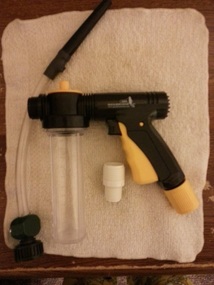|
When I first began to study music I was shocked by all of the expenses involved! Instruments, mouthpieces, sheet music, repairs, recordings, travel…it can add up very quickly! Here are a few tips to save money along the way. When in doubt, always consult a professional.
0 Comments
The arrival of football, marching band, and pumpkin spiced everything means that winter is around the corner. With that in mind, I would like to discuss a sensitive subject for all brass players, lip care.
First, it is important to stay hydrated! In fact, dehydration is one of the most common causes of dry or chapped lips. Next, it is important to frequently apply the lip balm of your choice. I prefer Blistex Medicated Lip Balm. I find it helpful to apply it throughout the day and generously prior to bedtime. Happy #TubaTuesday! GP Thank you to everyone who participated in and shared my Daily Routines Survey. The response has been amazing! We have nearly four times the number of participants from the 2004 survey with responses from all around the world.
I am currently compiling the information to publish on this site and through the Journal for the International Tuba Euphonium Association. I will have more information shortly. Happy practicing! George Palton  Let’s face it, cleaning a tuba is not a simple task. Yet regular maintenance is necessary in order to have a freely blowing instrument and to avoid sluggish valves. With that in mind I recently purchased the Quick Horn Rinse to see if it would make bathing a tuba any easier. It is simple to use and can connect to water in a variety of ways. I used an adapter to connect it to a standard shower hose. Further use will better evaluate its durability but my first impression is that it is well constructed. I followed the directions as instructed and it was indeed easier than soaking and scrubbing a tuba in the bathtub. I also believe it is more thorough because the Quick Horn Rinse allows flowing soap and water to reach places that snakes and brushes may not. However, it does not replace regular chemical cleaning or scrubbing out your valve sections with a brush. The instructions indicate that the valves and slides should be removed, wiped clean, lubricated, and resembled after using the Quick Horn Rinse. Before reassembly, I chose to dissemble the instrument completely, rinse again, and then to allow the tuba to air out overnight. Admittedly, this created additional steps to the process. That notwithstanding, cleaning a tuba is never a “quick” endeavor. But with this product it was a little faster and much easier. Most importantly it was more thorough. I recommend it for low brass musicians and music educators. Two new arrangements will be available through Cimarron Music in time for ITEC 2016 including:
Please check out my catalog of arrangements and transcriptions. Cheers! GP I must admit that I am excited to discuss two of my favorite things: food and daily routines. Mexican food is perhaps one of the biggest scams of all time. Each entree is nothing more than a reorganization of a few basic ingredients. And yet, every time that Taco Bell comes out with a new dish I stand in line eager to give them all of my money. I am comparably intrigued with brass daily routines.
In my playing and teaching I am a strong advocate of daily routines. In 2004, this inspired me to conduct a survey of daily routine habits that served as a foundation to a significant amount of the exercises on this website. There are a number of facets of playing that must be developed and maintained in order to display fundamental competency on a brass instrument. I don’t believe that any approach is the only way. Instead, there are a number of skills which require regular practice including Breathing, Mouthpiece Buzzing, Long Tones, Melodic or Flow Exercises, Slurring (slow, fast, and in varied registers), Low Register, High Register, Tonguing and Articulation, Flexibility, Fingering or Slide Technique, Playing by Ear, and Intonation. There are many great resources available to organize your fundamental practice. Currently I use a mixture of my own materials alongside the Arban Method, Mike Davis’ 20-Minute Warmup, Roger Bobo’s Mastering the Tuba, and the Brass Gym. These texts are well designed, interactive, and full of inspiration. But when reduced to their most basic elements they are all striving to fulfill the same objectives. In conclusion, it is important to be both regimented and flexible within your daily routine. Be consistent and adapt to your current performing demands. Whether it be with a Jacobs Turn Study, Chicowitz Flow Study, or a Bordogni etude down an octave, always strive for beautiful sound and musicality! In my previous blog post I addressed several prerequisites to clean articulation. Now I would like to continue the discussion with strategies to improve articulation, increase clarity, and improve your students’ ability to perform in varied styles.
There are two main variables within style as it relates to articulation. First, the front of the note can be pronounced with differing degrees of intensity. For instance, a stronger accented note may require a “toh” syllable while “doh” may be suitable for a lighter onset such as staccato. The next variable to consider is the space between notes. A staccato articulation usually will leave a great deal of space while a legato tongue will have very little separation. Regardless, it is very important to note that style contrast cannot alter the fundamentals of tone production! For optimal tone production, it is important to maintain a characteristic vowel shape regardless of the style. For low brass musicians I recommend an “OH” vowel. This means that the oral cavity and throat should be positioned as if you are saying “OH” while playing. It is also important to conceptualize the sound of each note as “brick shaped.” This requires focused breath support at the onset, even support and speed through the body, and an “OH” release at the end. Note shape can be visualized through the wave form analysis feature on apps such as Tonal Energy. How do we produce an onset with a consistent level of clarity? It begins with “air pressure.” If a faucet is said to have sufficient water pressure it means that the stream of water is strong and fast. Likewise, an instantaneous and focused air stream will improve clarity significantly. But it is important to remember that without water there is no water pressure, and there is not air pressure without a significant amount of wind. Improper tongue placement is often a cause of poor articulation. For low brass musicians I recommend a forward tongue placement with the tip of the tongue touching the middle of the top teeth. At times muddy articulation can be fixed by directing students to touch their teeth with the tip of their tongue. Speech and articulation correspond to one another and tongue placement can be further refined through verbal practice. Direct the student to say a rhythm to the desired syllable. If a student is too harsh a softer consonant such as “doh” may be useful. If their tonguing is weak a stronger syllable such as “toh” may be appropriate. If the student is used to moving their jaw while they speak, they may also do so while playing their instrument. Whenever possible, excess physicality is to be avoided. Breathing Gym techniques such as the “bow and arrow” or “paper airplane” can be used as a kinesthetic reinforcement of articulation. I strongly advocate the use of “wind patterning” to practice breath support and articulation. This requires the musician to blow air and tongue without vibrating the lips. This can be executed away from the instrument or through the instrument while fingering. Additionally, the intensity of the air can be measured by wind patterning onto a piece of paper. A focused onset will sound as if the paper is being flicked with your fingers. In conclusion, these prerequisites and techniques are a means to an end - to have the physical ability to perform in varied styles, and through active listening, to communicate a unified musical message.  Many band directors are perpetually frustrated with the quality of their students’ articulation. I do not want to downplay its importance; articulation cannot be ignored. Yet I often ponder, are we treating the symptoms or the disease? I believe articulation is similar to the game “Jenga.” Without an adequate foundation the structure crumbles. If the student is lacking prerequisites it is futile to focus on articulation. My next blog post will introduce strategies that are specifically geared towards improving articulation. Here are my thoughts regarding several items that must be addressed first. Posture and Holding Position: Often when diagnosing the cause behind a fundamental deficiency it is discovered that there is a “problem behind the problem.” For low brass musicians this is often traced back to their posture and holding position. If their posture is improper other aspects of performing follow suit. If the lungs cannot fill to their full capacity muscles become tense and other aspects of performing will suffer. Have you ever called tech support only to have someone ask you if your device is plugged in? As infuriating as that may be there is good reason why it is the first question asked. The simplest solution is usually the correct one.  Breath Support: All sounds are vibration. On wind instruments the vibration is created by our air column. Therefore, there is no sound without wind. To focus on articulation before establishing breath support is a waste of time. Prep, Onset, Follow Through: Consider using the term “onset” in place of “attack.” After all initiating a tone requires more of a refined touch. That notwithstanding, to focus solely on the onset is a bit short sided. A golf swing includes a backswing, point of contact, and follow through. To produce a tone we must include a preparatory breath, articulation, and follow though. Is the preparatory breath adequate? Is your ensemble breathing together? Are the students holding in the air prior to the onset? This often results in an explosion of air at the onset and a less than centered tone. Is their air supporting the sound through the body of the note? Through the phrase? Tempo, Rhythm, and Timing: If your ensemble is not in sync its sound can be muddy. This can easily be interpreted as poor articulation but an uneven tempo or rhythmic deficiencies are often the culprit. If their timing isn’t precise it will not sound clean. I have witnessed a phenomena in young low brass students that I refer to as “countis interuptis.” When a student encounters a rhythm which they are uncomfortable with their instinct is to slam on the brakes. This closes off the air stream and results in a less confident sound, therefore compounding the rhythmic errors. If a student is choking off their air supply and has poor timing then they cannot articulate successfully. Therefore it is imperative to incorporate rhythm and music reading skills into your rehearsal. With these prerequisites in place articulation should be addressed. I will discuss strategies in my next blog post. Happy #TubaTuesday! How we spend our time is a reflection of our priorities. If you are a serious musician then you will need to dedicate time to your craft. Yet we all have days, weeks, and even months when we become very busy. Some more than others! So, when our time is limited it is imperative to keep ourselves engaged and to make the most out of our practice time. Here are a few tips:
|
Archives
October 2021
Categories |

 RSS Feed
RSS Feed